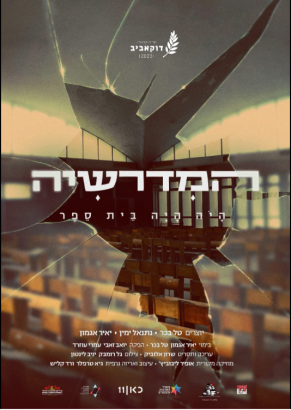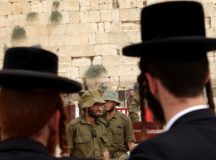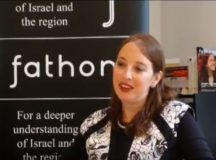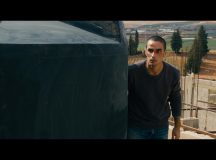Sara Hirschorn is the author of City on a Hilltop: American Jews and the Israeli Settler Movement (Harvard 2017). She reviews a new documentary film, Ha-Midrashia (Once Upon a School) directed by Tal Becher and Yair Agmon, two alumni of the training ground for the Religious Zionist elite and its shocking degeneration and eventual closure in 2007.
Imagine the Eton of Religious Zionism: a sprawling verdant campus in a pastoral setting. Young men, from the best families, coming together to study and build a network of intergenerational comradery. Its alumni now luminaries located across the elite ranks of Israeli society – government, military, hi-tech, medicine, the law, education, and academia. While there were no gowns, proud graduates spoke of a kind of invisible cloak they carried within them throughout their lives as a community. The men were beloved brothers, the institution venerated, its legacy revered.
Now picture the buildings aflame, ‘Head Master X is a Son-of-a-Bitch’ scrawled across every available surface in black graffiti, the shattered glass and twisted metal of a car thrown off the roof of the dormitories lying akimbo on the Great Lawn.
What happened in the course of a single generation of Religious Zionism that brought this venerable academy to its knees?
The fascinating and disturbing new documentary film, Ha-Midrashia (‘Once Upon a School’) directed by alumnus Tal Becher and his Sam Spiegel Film School classmate and long-time collaborator Yair Agmon, which had its recent premiere at the DocAviv festival and its Jerusalem debut at the Cinematheque (which the author attended last week), attempts to unravel the mystery of the ‘Midrashists’. At a time when the ultranationalist fringe has moved into the Knesset and Religious Zionism seems to have become “the Establishment,” what can the saga of this school illuminate about the past, present, and future of this movement?
It is a tragedy in two-acts: the first, the glory days of the Midrashit Noam, a high-school for men founded in Pardes Hanna in central Israel in 1945 by Yisrael Sadan and Rosh Yeshiva Yehoshua Yoggel that became a pillar of Religious Zionism (Noam means pleasantness in Hebrew). Archival home-footage is interspersed with in-depth interviews with former graduates, many with names recognisable to native Israelis (from former MK Yehuda Glick, to columnist Dror Eydar, to prominent members of the Israeli state, business, and academic communities), all of whom strongly identify as ‘Midrashists’ and credit the school for much of their character-building and future success.
One interviewee marvelled at how Rabbi Yoggel, born in Pinsk, could connect with the sense of Israeli peoplehood, but his unique pedagogical model that emphasised student autonomy, independent inquiry, and even an anti-establishmentarianism, shaped an entire generation. Another graduate, who no longer wears a kippah, comments wryly to the camera that ‘it looks like you can see it, even if it’s not there’ when filmed from the front, a kind of metaphor, perhaps, for the impact of the institution, whether or not its students remained within the religious fold. The cry from the audience, which included at least five self-identified Midrashists was, ‘Why didn’t you tell more about the good times, the Darchei Noam [Pathways of Pleasantness] of Midrashit Noam? To which the directors quipped, ‘because that’s not an interesting story.’
By the time the director himself attended the Midrashia, the halcyon days were over. Rabbi Yoggel’s retirement and death marked the second act for the school, which struggled under the new leadership of Ultra-Orthodox trained Rabbi David Bloch. By his own admission, Becher didn’t attend a single class (‘what classes?’, ‘what teachers?’ he told the audience, agape), although still credits the school’s unorthodox pedagogy with a true introspective and interpersonal education. But the director’s own limited admissions about his misbehaviour seem tame compared to the capers some students were getting up to in the Midrashia’s later years. Some might be attributed to fine young men testing the limits of authority, forging independence, and exploring group solidarity with relatively harmless antics: sit-ins against the administration, cutting class, getting pizzas delivered to the dorms, even hiring buses to go on a fieldtrip. But in the last decade before the school closed for good, student shenanigans took a much darker turn.
Truancy was the norm, vandalism of the buildings was pervasive, and an atmosphere of machismo, chaos, and violence reigned. Students were lighting fires in the hallways, spraying graffiti on every available surface, throwing lightbulbs, windows, bathroom sinks, and even one another out the window. One student-organised absentee fieldtrip to the beach resulted in two drowning deaths. Two weeks into his first year, one young man joining crowds of students jumping off the roof to crowd-surf was paralysed for life. Another alumnus reveals he was raped repeatedly by another student throughout his high-school years. The images captured on shaky camcorder footage (like a submission to a funniest home-video programme, though there was nothing was remotely humorous) and later, the panoramic shots of the smashed school buildings, is shocking. None of this was the ‘ways of pleasantness’ (Darchei Noam). Where in God’s name had the teachers, the administrators, the State, and even the parents gone?
In a poignant moment toward the end of the film, the director phones up his own mother to put to her this very question, how could she have known what was going on but let him stay in that environment and even send his younger brother there too? She acknowledged the realities were known but reinforced it was a family tradition and how attached the director was to his own classmates. The film suggests everyone had their own incentives to keep the school open – the students who relished their freedoms and formative experiences, the teachers and administrators who wanted to keep their jobs, and the Religious Zionist movement and the State, who wanted to perpetuate the mythos (if not the reigning ethos) of the institution to its bitter end in 2007.
At the Jerusalem screening, the director vigorously denied that the documentary was anything more than the story of the Midrashia. Yet, it is hard not to see the film as a mirror of the Religious Zionist society of 2023, how the elite, ‘the boys from the best families,’ the products of beloved and sacred institutions of Torah U’Madda (Jewish learning together with science/worldly learning), could behave like monsters. All the more so because the film isn’t about a yeshiva on a hilltop or drop-out juvenile delinquents, but a story that takes place well within the Green Line, about the cream of the crop of generations of Israeli society. The two-act structure is framed as a crisis of leadership and succession – but it seems to be a more capacious story that countenances the turpitude in the souls of the students, the abdication of control by school and state authorities, and the complicity of what seems to be good people in what evolves into a bad project. It is a profound cautionary tale, and ultimately, a story that ends in the tragedy of dismantlement and ruin.
Yet, the Midrashia lives on in the vibrant world of its graduates and their memories of a (long) moment when the school was in its prime – perhaps the directors of this ‘must-see’ film have it wrong: this too is the interesting story.




































